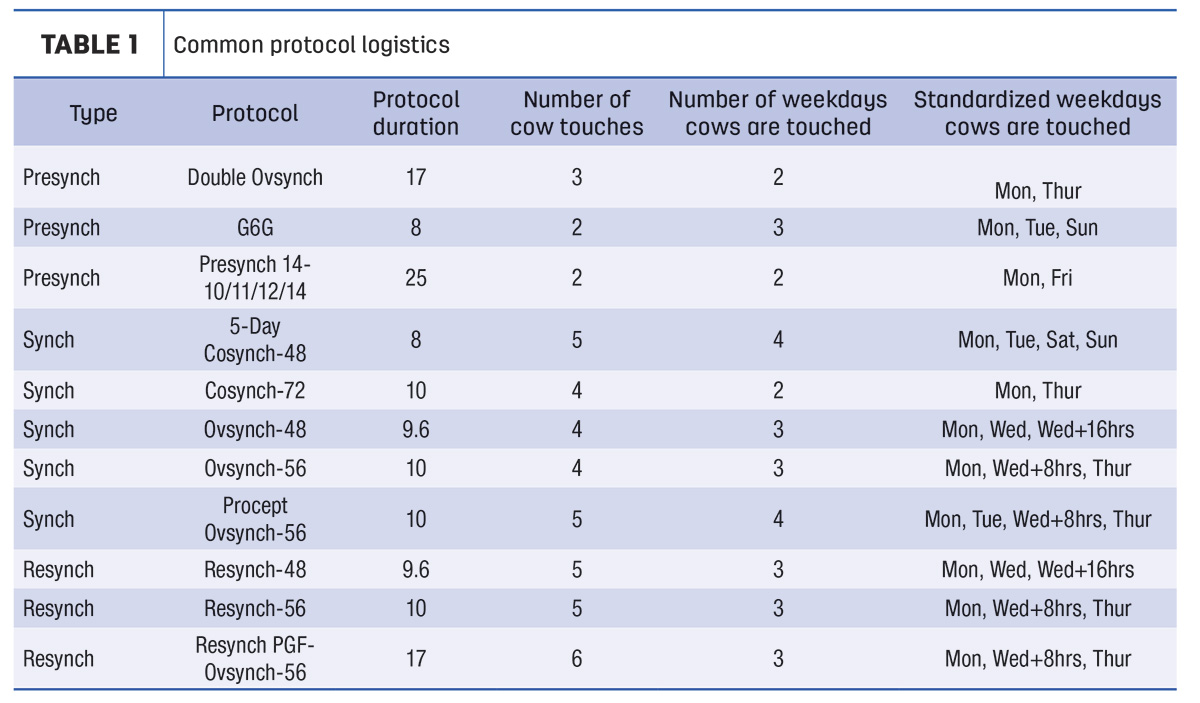Although reproduction is incredibly important, at times evaluating the mass of generated data can be challenging. A good first step in reviewing reproductive data is to review the reproductive plan. This includes synchronization protocols, voluntary waiting period, heat/activity detection monitors and employee training.
Evaluating reproduction is akin to evaluating nutrition. It is often said that there is never just one diet that is fed to a group of dairy cows. There is the formulated diet on paper, the mixed diet in the bunk and the diet the cows eat. Reproductive management is similar in that there is the synchronization protocol originally selected, the protocol programmed into your herd management system and the protocol executed by your team.
Taking time to review the reproductive plan can be easily overlooked in the grind of daily chores. However, regular evaluation of the reproductive plan provides necessary context for interpretation of measures evaluated more frequently. A plan evaluation provides some insurance against inadvertent changes due to employee protocol drift or herd management software setup. Your reproductive plan evaluation can be divided into three sections: plan definition, herd management software setup and protocol validation.
Plan definition
Defining your plan is obviously important – it should be uniquely yours based on what is right for your cows and your farm goals.
This task can seem overwhelming with many tools available to manage estrus detection and ovulation synchronization. Therefore, involving your entire farm reproductive management team allows for immediate feedback on parts of the plan that work well and challenges encountered with the current protocol for the individuals tasked with executing it. Taking a teamwork approach to plan development should account for farm labor availability, staff training and available technology – optimizing them to achieve farm goals.
Some protocols may not have the same success rate on every farm. The best protocol for a farm is the one that can be delivered consistently and reliably.
Voluntary waiting periods (VWPs) should be clearly defined for all lactation groups. Several studies have demonstrated that there are multiple VWPs that can provide successful conception rates. When evaluating 283 farms in the mySYNCH database – a reproductive management tool from Parnell – farms with a conception rate ranking in the top 10% did not have significantly different VWPs compared to farms outside of the top 10%. This suggests that success depends on many other things than the VWP and should therefore be optimized to fit your farm’s reproductive goals.
If activity monitors are available, the plan should define when and how they are used to help manage reproduction. Regardless of estrus detection method, clearly establish how synchronization (synch) is used for cows that were not detected in heat or did not settle to earlier breedings. The basic format of a synchronization program includes presynch, synch for timed artificial insemination (TAI) and resynch of open cows. Some farms opt to breed cows to estrus during the presynch period while others breed 100% to TAI.


The improvement of dairy cow fertility through estrus synchronization began in 1995, with the development of Ovsynch. Although Ovsynch alone did not increase conception rates compared to breeding based on detected estrus, it did allow insemination of cows where estrus was never detected, increasing the overall insemination rate.
A summary of 37 studies found that nearly a quarter of cows are still anovular by 60-70 days postpartum. Without synchronization protocols in place, anovular cows are not bred, and there is one thing we know for sure: Cows that are not inseminated cannot get pregnant.
Drs. Pursley and Wiltbank discovered early on that cows had higher conception rates when the first gonadotropin-releasing hormone (GnRH) injection of Ovsynch was given between the fifth and ninth day of the estrous cycle. This led to the development of numerous presynchronization protocols that improved conception rates to TAI.
Resynchronization protocols that begin with GnRH can even be started prior to pregnancy diagnosis to save time. To many dairy producers, giving potentially pregnant cows an injection of GnRH is worth the cost of getting open cows bred one week earlier.
Herd management software setup
There are many tasks where humans are still more capable than computers, but the application of clearly defined reproductive protocols to cows flowing through a dairy system is not one of those. Ensure that your protocol is correctly set up in your herd management system so that tasks can be completed for the right cows at the correct time. Generally, the best method of doing this is through the support resource at your herd management software company. Although the setup of these programs can be complex, it is important that you understand what is currently programmed and that you are able to monitor it in case unintended changes are made.
Protocol validation
Finally, it is necessary to periodically confirm that the protocol setup in your herd management system is a match to your plan protocol. If your protocol does not match a scientifically-proven protocol and you still achieve exceptionally good reproductive rates, then carry on. However, if reproductive rates are less than ideal, you may be missing an opportunity to improve reproductive efficiency and efficacy.
Implementing the plan
Unlike waiting several weeks for the results of pregnancy diagnosis, there is no time delay when evaluating the reproductive plan. If a change is made, it can be implemented immediately. If a change was unintentionally made, it can be fixed immediately. This is why routinely evaluating the reproductive plan is so important.
Once you have clearly established your plan, the next step is to use data to evaluate your plan’s execution. The foundation provided by a solid plan makes the evaluation of plan execution data much more efficient.
References omitted but are available upon request by sending an email to the editor.










